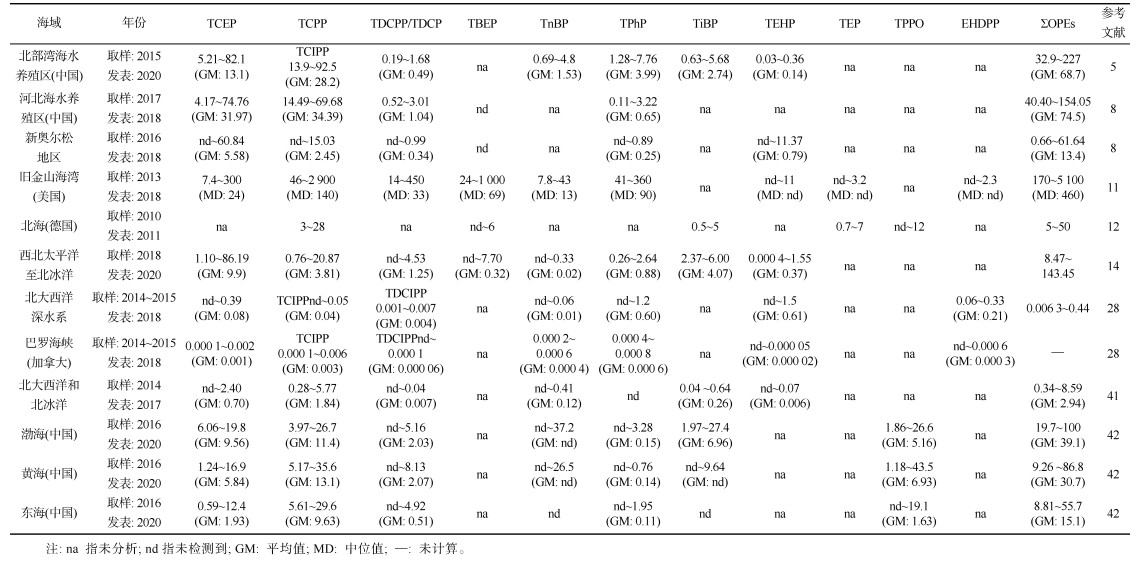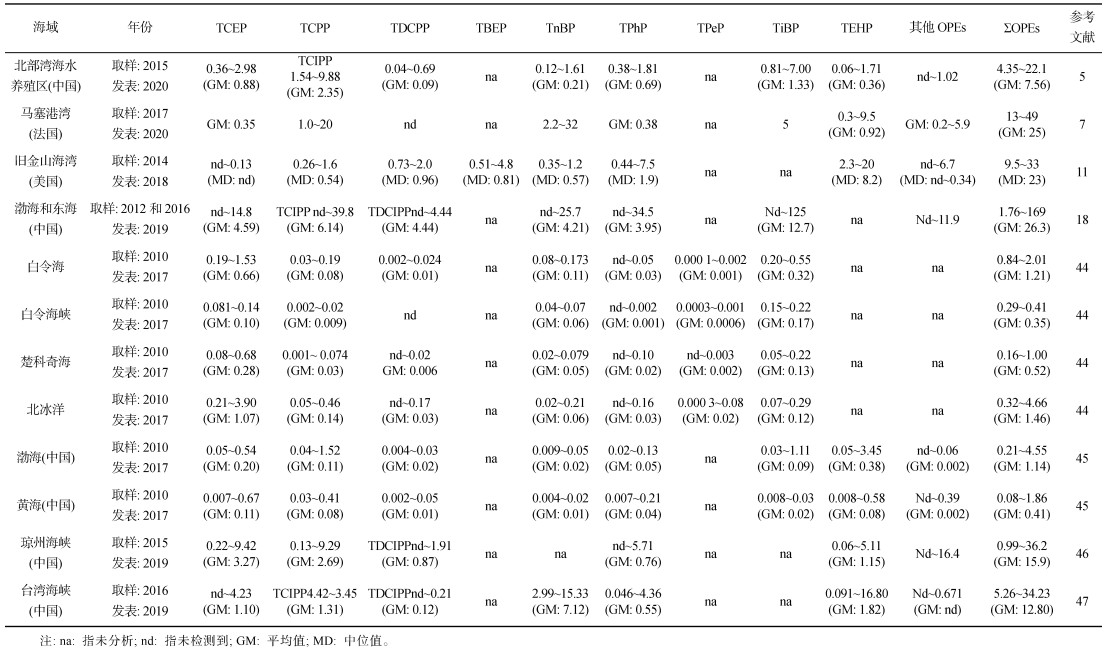
文章信息
- 梁桂珠, 张玉凤, 刘鹰, 程学文, 张韬, 刘志强, 杨萌, 江盈, 刘佳琪. 2023.
- LIANG Gui-zhu, ZHANG Yu-feng, LIU Ying, CHENG Xue-wen, ZHANG Tao, LIU Zhi-qiang, YANG Meng, JIANG Ying, LIU Jia-qi. 2023.
- 海水和海洋沉积物中有机磷酸酯的研究进展
- Review of organophosphate esters in seawater and marine sediments
- 海洋科学, 47(2): 86-99
- Marine Sciences, 47(2): 86-99.
- http://dx.doi.org/10.11759/hykx20220428001
-
文章历史
- 收稿日期:2022-04-28
- 修回日期:2022-08-06
2. 设施渔业教育部重点实验室(大连海洋大学), 辽宁 大连 116023;
3. 国家环境保护近岸海域生态环境重点实验室, 辽宁 大连 116023;
5. 大连市环境监测中心, 辽宁 大连 116023;
4. 大连海洋大学水产与生命学院, 辽宁 大连 116023
2. Key Laboratory of Environment Controlled Aquaculture, Ministry of Education, Dalian 116023, China;
3. State Environmental Protection Key Laboratory of Coastal Ecosystem, Dalian 116023, China;
5. College of Fisheries and Life Science, Dalian Ocean University, Dalian 116023, China;
4. Dalian Ecological Environment Monitoring Center, Dalian 116023, China
有机磷酸酯(OPEs)可作为阻燃剂、增塑剂, 被应用于建筑材料、汽车、各类家具、电子产品等[1]的生产制作中。自2009年溴系阻燃剂在全世界范围内被禁用后, OPEs作为其最佳的替代品, 产量和使用量逐年递增。因为OPEs不是通过化学键与基质材料结合, 所以很容易通过挥发、磨损等形式释放到周围环境中去, 形成一类新型的持久性有机污染物, 对生态环境和人类健康造成了巨大的威胁[2]。目前, 在不同环境中均已检测到OPEs, 如: 水环境[3]、大气[4]、沉积物[5]、土壤[6]和生物体内[7], 在极地地区也发现了OPEs[8]。OPEs具有较高毒性[3]、难降解[1]和远距离迁移[9]等特性, 特别是氯代有机磷酸酯(Cl-OPEs)较难降解, 会长期存在环境中, 可通过食物链在生物体内累积放大, 其毒性较强, 会对环境和人类造成危害[6], 早在1995年和2000年OPEs先后两次被列入欧盟优先控制污染物的名单中。因此, 近些年来, OPEs存在的问题受到了广泛的关注, 但对海洋中OPEs的相关研究仍非常有限。
海水和海洋沉积物是海洋环境的两大重要的环境介质, OPEs通过河流输入等途径传输到海洋后, 会在海水和海洋沉积物当中传输和储存, 因此, 海水和海洋沉积物中OPEs的分布、组成和来源特征对合理评估OPEs带来的海洋生态影响至关重要。但当前对海水和海洋沉积物中OPEs的研究仍非常有限。本文分析了海水和海洋沉积物中OPEs的分析方法、分布、组成和影响因素等, 并对海水和海洋沉积物中OPEs的研究进展进行了总结, 以期能对未来OPEs的相关研究与科学管理提供参考和帮助。
1 OPEs的分析方法 1.1 前处理方法表 1列出了海水中OPEs常用的萃取方法, 海水样品的前处理方法主要采用液液萃取法(LLE)和固相萃取法(SPE)。LLE是前处理海水样品较为广泛方法之一。LLE对海水中的OPEs回收率(66%~105%)[11]较好, 回收率高且样品无需过滤, 但LLE会产生乳化现象, 且消耗有机溶剂的量较大。而分散液液微萃取(DLLME)[15]、中空纤维液相微萃取(HF-LPME)[13]这两个小型化的LLE技术可以克服LLE的一些缺点, 已应用于海水样品的萃取中。SPE对小柱的选择比较关键, 其中HLB小柱(hydrophilic lipiphilic balance)对分析物保留效果好, 回收率可在66%~110% 之间[5, 10]。Andresen等[16]比较了LLE和SPE对TCEP的萃取方法, 发现SPE可将TCEP的回收率从31% 提高到67%, 但此方法对磷酸三辛酯(TEHP)等疏水化合物的萃取效果更差, 这可能与SPE过程中存在吸附问题影响萃取效率有关[17], 反而使用LLE能提高TEHP萃取效率[3, 16]。因此当萃取效果较差时, LLE和SPE可根据实际情况相互结合利用。
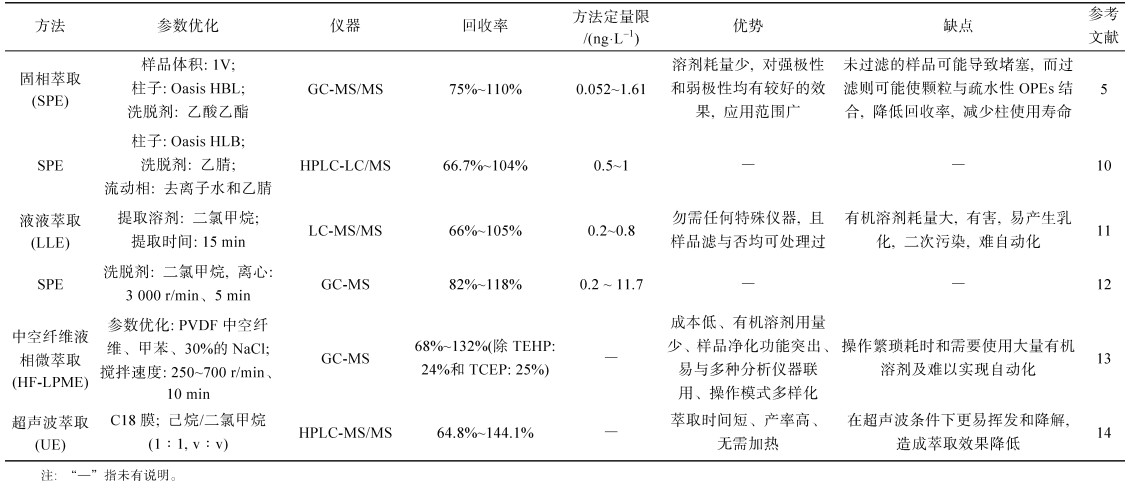
|
表 2列出了海洋沉积中OPEs常用的萃取方法, 海洋沉积物样品前处理方法主要有索式提取法(SE)、加速溶剂萃取法(ASE)、微波辅助提取技术(MAE)和超声波辅助萃取法(UAE)等。采用SE[5]对海洋沉积物中OPEs进行前处理, 回收率在82%~ 118%, 其优点是萃取效率高, 设备简单, 但耗时较长。目前ASE和MAE对海洋沉积物中OPEs的萃取效率分别为73%~105% 和62%~106%, 与SE相当, 具有萃取率高、有机溶剂体积小的优点[19-20]。采用UAE从海洋沉积物中提取OPEs, 目标回收率可达52.8%~132.8%[21]。SPE方法同样适用于海洋沉积物样品的萃取, 采用SPE萃取海洋沉积物中的OPEs, 回收率在40%~141%[10, 18]。在SE的基础上, 动态超声辅助溶剂萃取(DSASE)[22]和动态微波辅助萃取(DMAE)[23]已被开发并应用于固体样品的在线萃取系统, 这两种方法的提取效率大于95%, 且分析速度较快[24-25], 但定量的不确定性较高。

|
用于分析海水和海洋沉积物中OPEs的仪器设备主要为气相色谱或液相色谱(GC-或LC-)与不同类型的质谱(MS)相结合。由于OPEs种类多, 理化性质存在较大的差异, 需要高选择性和高灵敏度的分析仪器来满足对OPEs的痕量分析。气相色谱-氮磷检测(GC-NPD)[26]是较早常用来测定OPEs, 具有良好的分离能力, 但其具有选择性不够高、稳定性低等缺点。随着MS技术的发展, 气相色谱-质谱(GC-MS)应用越来越广泛。与GC-NPD相比, GC-MS具有更高的选择性和准确的定量能力, 其方法定量限良好。有研究用GC-MS来分析海水中OPEs, 方法定量限为0.2~11.7 ng/L, 但该仪器也有易受基质干扰、有噪音等缺点[12]。串联质谱(MS/MS)检测器能够很好地克服气相色谱-质谱联用的缺点, 气相色谱-三重串联四极杆质谱(GC-MS/MS)具有气相色谱的高分离效能, 可利用质谱准确鉴定化合物结构的特点, 三重串联四极杆质谱检测器(TQMS或QqQ)能允许多重反应监测(MRM)模式, 这是GC-MS(SIM模式)或带离子阱的GC-MS/MS(SRM模式)不能实现的。液相色谱-串联质谱仪(LC-MS/ MS)主要的特点是在复杂基质分析中具有良好的选择性和灵敏度。该方法可有效富集并去除基质干扰, 灵敏度高, 线性范围宽, 针对海水和海洋沉积物样品中各OPEs化合物的回收率结果均在52.1%~118.1%之间, 相对标准偏差均小于12.0%, 方法整体回收率和精密度均满足准确定量要求, 适用于分析海水和海洋沉积物中的痕量OPEs[27]。也有学者对GC-MS和HPLC-MS/MS分析海水中OPEs进行的比较, 结果表明, GC-MS分析OPEs的回收率在48%~128%, 使用HPLC-MS/MS后提高了回收率(72%~125%)[28]。
2 海洋中的OPEs 2.1 海洋中OPEs的毒性效应及迁移转化OPEs具有神经毒性、发育毒性、内分泌干扰性和致癌性等[29], 如磷酸三异丁酯(TiBP)可能具有神经毒性, 磷酸三氯丙酯(TCPP)、磷酸三(2-氯乙基)酯(TCEP)和磷酸三(1, 3-二氯异丙基)酯(TDCPP)对动物有潜在的致癌性等。当前, 已有报道证实了OPEs在海洋食物网进行累积[7, 30], OPEs对底栖生物、浮游生物、鱼类和哺乳类等海洋生物造成了一定的影响。TCPP长期暴露会影响紫贻贝免疫相关基因的表达、血细胞的氧胁迫和细胞凋亡等[31]; 磷酸三苯酯(TPhP)的暴露会影响小球藻的呼吸、渗透调节和膜脂质的合成[32], TDCPP显著抑制三角褐指藻的生长[33], 产生发育毒性; 在莱州湾海鱼的不同组织中检测到肝脏中OPEs的含量最高, 这会影响其机体免疫功能[34]; 有研究在海豚不同组织中OPEs的分布模式为膀胱和脂肪存储组织中OPEs含量较高, 肝脏中OPEs含量较低, 呈现出高代谢活性问题, 而脑组织中OPEs能够穿过膀胱-脑屏障, 这表明OPEs具有潜在的神经毒性风险[35]。以上这些研究都从不同角度证实了OPEs会对海洋生物产生潜在的毒性效应。
OPEs普遍具有半挥发性, 溶解度相对较高, 广泛存在于大气、海水、海洋生物和海洋沉积物四大介质中, 其迁移转化也较为复杂。每年大陆环境中的OPEs主要通过河流输入、大气沉降(干/湿沉降)两大途径输送到海洋。OPEs在海洋环境中主要通过大气气粒分配、海气界面、海水-颗粒物界面、海水-沉积物界面、海水-生物体界面和海洋沉积物中孔隙水-颗粒物界面进行迁移转化, 每个界面行为都会对海洋环境中OPEs分布和环境行为产生影响。从河流和大气输送进入海洋环境中的OPEs分为溶解态和颗粒态, 在海水环境中与颗粒物结合的OPEs会通过沉降作用向沉积物中迁移, 海水中溶解态的OPEs与沉积物中OPEs时刻发生着扩散行为, 同样海水和沉积物中OPEs会被生物所吸收, 转移至生物体内。OPEs在海洋环境中运输、沉降、积累和储存的迁移转化途径如图 1所示。
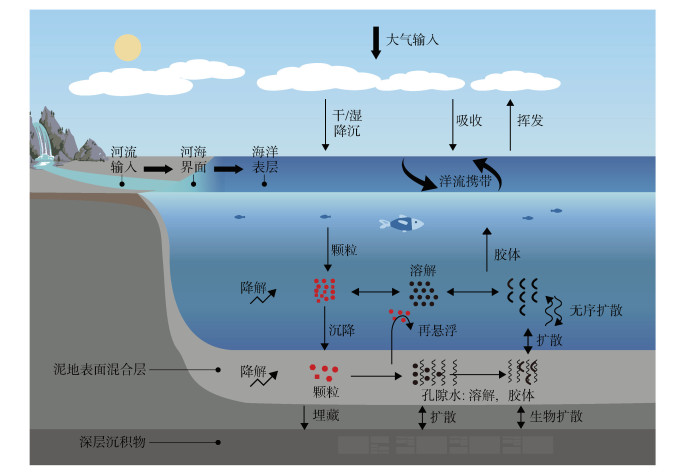 |
| 图 1 海洋环境中OPEs的传输途径 Fig. 1 Transmission route of OPEs in the marine environment |
河流输入和大气沉降是海水环境中OPEs的主要来源。在现有的研究中, 渤海40条河流每年向海洋输送OPEs总量为16 t, 输送三苯基氧磷(TPPO)总量为114 t/a[36], 德国重要支流向北海输入OPEs约为50 t/a[12]。同时, 每年至少有13~260 t OPEs从大气层进入到地中海开放水域[37], 估算干沉降通量为0.19~2.85 ng·m–2·d–1; 德国北海[38] 8种OPEs干沉降通量为9~240 ng·m–2·d–1, 大气中OPEs通过干沉降进入到海洋的总量为0.71 t/a; 中国南海北部[39] 9种OPEs的干沉降通量为8.2~27.8 ng·m–2·d–1, 通过大气干沉降进入海洋中OPEs的总量达到4.98 t/a, 2016年黄海和渤海9种OPEs干沉降总量为12 t/a [40], 到2020年黄渤海大气中11种OPEs的干沉降通量为202~1 869 ng·m–2·d–1, 渤海海域干沉降总量为18.3 t/a, 此研究结果低于河流输入渤海总量的1个数量级左右[4]。基于以上研究, 我国南海和黄渤海大气干沉降进入海洋的OPEs总量约为17 t/a(南海4.98 t/a, 黄渤海12 t/a), 由于缺少东海数据, 所以, 通过大气干沉降进入到我国海域的OPEs总量暂时还不能确定。
2.2.2 海水中OPEs的浓度表 3中列出了部分海域海水中OPEs的浓度水平。目前, 海水环境中OPEs的浓度差异较大, OPEs的总浓度范围在0.34~5 100 ng/L之间(图 2)。在大洋(北大西洋和北冰洋)、极地(新奥尔松地区)、我国局部海域(渤海)和海水养殖区(河北海水养殖区)海水中OPEs的平均浓度分别为2.94、13.46、39.1和75.51 ng/L。海水养殖区的污染水平相对较高, TCPP、TCEP和TDCPP 3种Cl-OPEs为众多海域中OPEs的主要组分, 这是由于3种Cl-OPEs用途较为广泛且支链结构稳定不易被降解, 因此Cl-OPEs在海水中稳定存在而难以析出[9]。在现有研究中, TCPP、TCEP和TDCPP在海水中浓度范围分别为未检出~2 900 ng/L、未检出~300 ng/L和未检出~450 ng/L。
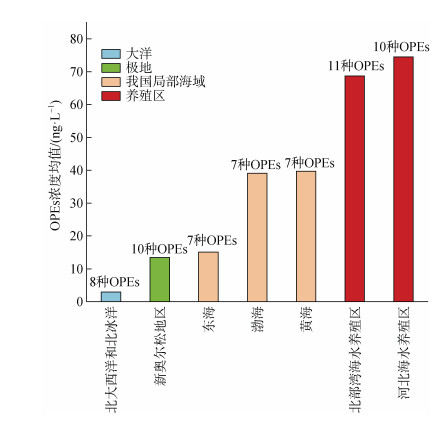 |
| 图 2 不同海域海水中总OPEs的平均浓度 Fig. 2 Average concentration of total OPEs in seawater from different sea areas |
海水中OPEs浓度的分布通常会受到陆源排污、海洋环流、水团等因素的影响, 其浓度的水平分布总体上表现出从河口、近岸到远海逐渐递减的趋势。以单体TCPP为例, 德国易北河口及北海海域中OPEs的浓度分布表现出由河口(40~250 ng/L)到海洋(3~28 ng/L)明显的下降趋势[12], 环渤海河流[36]中OPEs的浓度(4.6~921 ng/L)明显高于渤海海域[41](3.97~ 26.7 ng/L)。此分布模式的原因可能是河口及近岸海域受到入海河流携带的陆源OPEs引起的, 悬浮颗粒物的吸附及在从河口、近岸向远海传输过程中OPEs的降解等因素也会引起此结果[13]。也有研究表明OPEs的浓度与盐度呈负相关性, 即随着海水盐度的增加而降低[43]。同时, 由图 3可知, 不同海域中OPEs各单体的比例不相同, 这与OPEs的污染源及强度、OPEs单体的物理化学性质、积累特征和降解性能的差异有关。
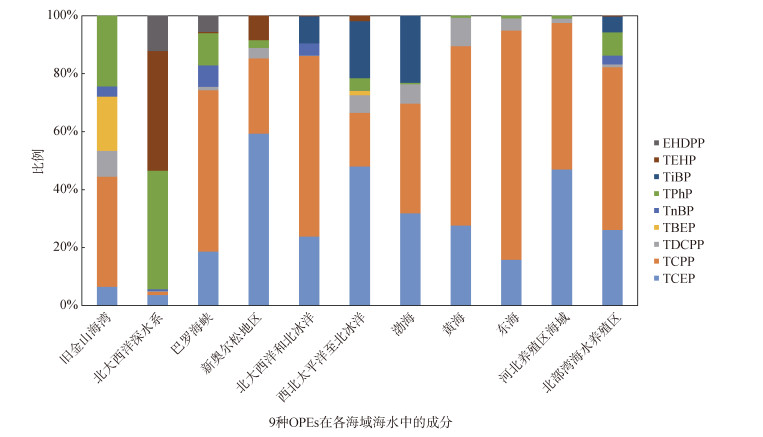 |
| 图 3 各海域海水中9种OPEs浓度百分比组成 Fig. 3 Concentration-percent concentration of 9 OPEs in seawater of each sea area |
海水环境中OPEs浓度表现为表层高于底层, 并且在北极海域也表现出相似的趋势[28], 表现出这种分布趋势的原因可能有3个: 1)由于陆源排放的OPEs经河流输入到海洋, 会大量滞留在海水表层, 导致OPEs在海水表层的浓度极高。渤海、黄海和东海3大海域的7种OPEs垂直分布表明, 表层水体中TCEP、TCPP和TPPO的浓度高于深层水体[42], 同样, 珠江8个入海口[13]的研究结果也表现出了相似的结果; 2)OPEs在海水中的溶解度会随海水盐度的增加而降低, 海水表层的盐度略低于底层盐度, 会导致表层海水中OPEs的浓度高于底层; 黄海和东海[42]海水的盐度均表现出表层低于底层(黄海海水表层盐度: 31.6, 底层盐度: 32.0; 东海海水表层盐度: 33.4, 底层盐度: 34.0), 海水中的OPEs浓度与盐度呈负相关, 德国易北河口到北海海水中OPEs的浓度也表现出相似的趋势[12]; 3)OPEs会通过大气沉降输入到表层海水中, 也导致海水表层高于底层的垂直分布, 根据研究数据显示, 德国北海8种OPEs的干沉降通量为0.71 t/a[38], 渤海大气中11种OPEs的干沉降通量达到18.3 t/a[4]。
2.3 海洋沉积物中的OPEs 2.3.1 海洋沉积物中OPEs的来源颗粒沉降和海洋食物网是海洋沉积物中OPEs的主要来源。研究发现OPEs的单体和δ15N(同位素)在底层物种之间可能存在正相关关系, OPEs可通过颗粒沉降进入底层沉积物中[3]。同时, 海洋食物网中的生物普遍检出OPEs [7], OPEs可能会通过底栖食物网进一步积累到海洋沉积物中。
2.3.2 海洋沉积物中OPEs的含量表 4汇总了部分海洋沉积物中OPEs的含量, 根据现有文献海洋沉积物中OPEs的总含量范围在0.08~169 ng/g(干质量)之间, 其中TiBP、TCPP和TEHP占众多海域的主要成分。在极地(北冰洋)[44]、我国局部海域(渤海)[45]、海水养殖区(北部湾)[5]、海峡(琼州海峡)[46]和海峡(台湾海峡)[47]海洋沉积物中OPEs的平均含量分别为1.46、1.14、7.56、15.9和12.8 ng/g(干质量), 并表现出了从极地到港湾海洋沉积物中OPEs含量呈递增趋势(图 4)。其中海洋沉积物的主要的OPEs组分TiBP、TCPP和TEHP在海洋沉积物的含量范围分别为未检出~125 ng/g(干质量)、未检出~39.8 ng/g(干质量)和未检出~20 ng/g(干质量)。
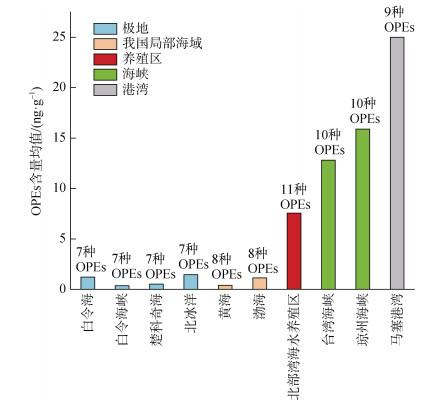 |
| 图 4 不同海域海洋沉积物中总OPEs的平均含量 Fig. 4 Average concentration of total OPEs in marine sediments from different sea areas |
海洋沉积物中OPEs含量和单体组成与海水、海水悬浮颗粒物中有所不同。黄、渤海表层沉积物中OPEs的主要组分为TEHP, 但在海水中并未检出。Western Scheldt河口[48]和珠江口河口[49]环境水体悬浮颗粒物的OPEs总量均高于沉积物中含量(Western Scheldt河口高2~12倍, 珠江口高约2倍), 但TCEP、磷酸三(1, 3-二氯异丙基)酯(TDCIPP)在珠江口表现出与Western Scheldt河口相反的趋势, 而磷酸三(2-正丁氧乙基)酯(TBEP)在Western Scheldt河口[48]和珠江口[49]都表现为悬浮颗粒中含量低于沉积物。欧洲易北河口、谢尔特河口、莱茵河口、泰晤士河口、波河口、吉伦特河口、多瑙河口和台泊河口8个欧洲河口的沉积物中OPEs指纹与中国小清河口有很大的差异[50]。
2.3.3 海洋沉积物中OPEs的分布及影响因素海洋沉积物中OPEs的含量分布表现出港湾、近岸海域和沿岸城市经济发达区域较高的趋势, 且OPEs的主要组分存在差异。在马塞港湾[11]附近的海域沉积物中OPEs的浓度普遍较高, 比偏远海域高出1个数量级别, 磷酸三丁酯(TnBP)为主要组分。黄渤海表层[45]沉积物中OPEs分布规律表现出沿岸城市经济越发达区域和近岸海区的OPEs的含量较高的特点, 其中TCEP为Cl-OPEs的主要化合物, 而TEHP为非Cl-OPEs的主要化合物。有研究发现在极地附近表现出高纬度含量较高, 从白令海峡至北冰洋中部海洋沉积物中OPEs的浓度随着纬度的增加而普遍增加, 且在高纬度海域以TCEP和TiBP为主[44]。
海洋沉积物的柱状样品中OPEs含量和组分的变化趋势能够探究OPEs的污染现状和不同年代的污染历史。海洋沉积物的柱状样中OPEs的垂直分布特征表现为: 在一定深度范围内OPEs总含量呈现最大值, 其会随着深度的增加而减小, 尤其是经济地区较为发达的地区, 层次分明尤为明显。以我国为例: 钦州湾[21]、北方近海海域[18]和莱州湾[51]沉积物柱状样中OPEs含量显著低于华南珠江三角洲[52], 而OPEs的组分是以非Cl-OPEs(TPhP、TnBP和TiBP)为主, 且都在一定深度范围内(钦州湾0~23 cm [21]、北方近海海域0~31 cm [18]、莱州湾0~5 cm[51]、珠江三角洲0~12 cm [52])出现总含量最大值, 这也揭示了近年来OPEs在该研究区域的密集输入。海洋沉积物的柱状样品中OPEs组分的垂向分布可能受到三个原因的影响: (一)单种OPEs的生产、使用和排放强度的变化; (二)沉积后的转化或降解; (三)相对亲水的OPEs具有较低的沉积物吸附系数和较高的水溶性,这可能有助于随着时间的推移向下扩散, 将OPEs输送到更深的沉积物中[51]。
海洋沉积物中OPEs组成比例与海水不同(图 3,图 5)。海洋沉积物中OPEs含量、组成和分布会受到辛醇-水分配系数、有机碳含量及区域污染源等因素的影响。研究表明,随着辛醇-水分配系数(lgKow)增大,沉积物中OPEs的含量也逐渐增大,这是由于lgKow越大的OPEs越容易吸附到颗粒物上,这也是导致部分区域海洋沉积物中OPEs的主要组分在海水中却没有检出的主要原因。以TEHP为例, TEHP的lgKow为9.49, 在水样中几乎检测不出, 但在沉积物中TEHP是主要组分, 仅次于Cl-OPEs [36, 45]。同样, 沉积物中OPEs含量也受到沉积物中有机碳(TOC)的影响, 在狮子湾[53]和渤海[54]沉积物的研究中, 都发现TOC含量与OPEs浓度存在着一定的正相关性, OPEs污染比较严重区域的沉积物中发现了较高的TOC, 这可能加强了OPEs从水相到沉积物的扩散, 从而导致OPEs在沉积物中积累增加[3, 55], 以上表明TOC对沉积物OPEs的固存具有重要作用。
 |
| 图 5 各海域海洋沉积物中9种OPEs含量百分比组成 Fig. 5 Concentration-percent concentration of 9 OPEs in marine sediments of each sea area |
目前, 对于海洋沉积物中OPEs储存量的研究较为有限, 有研究表明, 2010年我国黄渤海表层沉积物中8种OPEs的储存量估算为0.474~26 t[45]。2018年, 我国渤海沉积物中14种OPEs的储存量为101.5 t[54], 此结果表明, 2010—2018年我国OPEs的使用量在不断增长, 污染程度呈现上升趋势。2010年中国第四次北极科学考察中, 北冰洋盆地海洋沉积物中7种OPEs储量范围在17~292 t[44], 2015和2016年北极海洋海水中仅三-(2-氯异丙基)磷酸酯(TCIPP)的储存量达到了3.4 t/a[28]。OPEs与持久性有机污染物类似, 在偏远海洋环境中OPEs的净通量能遵循空气-地表水-较深水域的途径, 然后积累在海洋沉积物中, 如果OPEs在海洋中循环积累, 最终可能会在遥远的海洋沉积物中形成一个巨大的储存库。
3 结论和展望近年来, 有机磷酸酯阻燃剂的使用及排放量都将呈现只增不减的趋势, 全球海域的海水和沉积物中的OPEs污染程度逐年递增, 且在极地海洋环境中能检测到含量较高的OPEs。由于OPEs具有较强的毒性效应, 也使其在海洋环境中的分布及环境行为备受关注。本文综述了海水和海洋沉积物中OPEs的研究进展, 得出以下结论:
1) 海水中的OPEs主要来自河流输入和大气沉降的输送。TCPP、TCEP和TDCPP 3种Cl-OPEs是主要污染物, 我国海域OPEs的污染水平虽不及发达国家地区的海域, 但已处于中等污染水平。OPEs在海水中的分布特征是: 海水环境中OPEs浓度表现为表层高于底层, 人为活动是影响其在海水中分布的主要因素。
2) 海洋沉积物中OPEs的含量分布表现出港湾、近岸海域和沿岸城市经济发达区域较高的趋势。TCPP、TiBP和TEHP为海洋沉积物的主要组分, 沉积物中OPEs分布受辛醇-水分配系数(lgKow)和总有机碳(TOC)的影响。
目前国内外对海水和海洋沉积物中OPEs的研究数据还相对较少, 人们对OPEs在海洋环境的分布特征、影响因素等方面的研究尚且不足, OPEs在海洋环境介质中的迁移转化、生态风险和毒性机制等问题仍待进一步研究, 尽管OPEs的生物累积和生物放大已有一些研究基础, 但缺乏环境浓度下长期慢性暴露等毒性数据, 仍亟需开展进一步的相关研究。
| [1] |
高小中, 许宜平, 王子健. 有机磷酸酯阻燃剂的环境暴露与迁移转化研究进展[J]. 生态毒理学报, 2015, 10(2): 56-68. GAO Xiaozhong, XU Yuping, WANG Zijian. Progress in environment exposure, transport and transform of organophosphorus flame retardant[J]. Asian Journal of Ecotoxicology, 2015, 10(2): 56-68. |
| [2] |
SUNDKVIST A M, OLOFSSON U, HAGLUND P. Organophosphorus flame retardants and plasticizers in marine and fresh water biota and in human milk[J]. Journal of Environmental Monitoring, 2010, 12(4): 943-951. DOI:10.1039/b921910b |
| [3] |
WANG X, ZHU Q Q, YAN X T, et al. A review of organophosphate flame retardants and plasticizers in the environment: Analysis, occurrence and risk assessment[J]. Science of The Total Environment, 2020, 731(9): 139071. |
| [4] |
WU J H, ZHANG Y F, SONG L, et al. Occurrence and dry deposition of organophosphate esters in atmospheric particles above the Bohai Sea and northern Yellow Sea, China[J]. Atmospheric Enviroment, 2022, 269: 118831. DOI:10.1016/j.atmosenv.2021.118831 |
| [5] |
ZHANG R J, YU K F, LI A, et al. Occurrence, phase distribution, and bioaccumulation of organophosphate esters (OPEs) in mariculture farms of the Beibu Gulf, China: A health risk assessment through seafood consumption[J]. Environmental Pollution, 2020, 263: 114426. DOI:10.1016/j.envpol.2020.114426 |
| [6] |
DODDER N G, MARUYA K A, FERGUSON P L, et al. Occurrence of contaminants of emerging concern in mussels (Mytilus spp.) along the California coast and the influence of land use, storm water discharge, and treated wastewater effluent[J]. Marine Pollution Bulletin, 2014, 81(2): 340-346. DOI:10.1016/j.marpolbul.2013.06.041 |
| [7] |
SCHMIDT N, CASTRO-JIMÉNEZ J, OURSEL B, et al. Phthalates and organophosphate esters in surface water, sediments and zooplankton of the NW Mediterranean Sea: Exploring links with microplastic abundance and accumulation in the marine food web[J]. Environmental Pollution, 2021, 272: 115970. DOI:10.1016/j.envpol.2020.115970 |
| [8] |
高宇航. 海洋典型区域有机磷酸酯的环境分布与生物富集[D]. 上海: 上海海洋大学, 2018. GAO Yuhang. Distribution characteristics and bioaccumulation of organophosphate esters in the typical marine area[D]. Shanghai: Shanghai Ocean University, 2018. |
| [9] |
房晓静, 杨圣文, 张洪海, 等. 海洋及其上空大气中有机磷酸酯的研究进展[J]. 海洋科学, 2020, 44(9): 154-165. FANG Xiaojing, YANG Shengwen, ZHANG Honghai, et al. Review of organophosphate esters in oceans and atmospheres[J]. Marine Sciences, 2020, 44(9): 154-165. |
| [10] |
HU M Y, LI J, ZHANG B B, et al. Regional distribution of halogenated organophosphate flame retardants in seawater samples from three coastal cities in China[J]. Marine Pollution Bulletin, 2014, 86(1/2): 569-574. |
| [11] |
SUTTON R, CHEN D, SUN J, et al. Characterization of brominated, chlorinated, and phosphate flame retardants in San Francisco Bay, an urban estuary[J]. The Science of the Total Environment, 2019, 652: 212-223. DOI:10.1016/j.scitotenv.2018.10.096 |
| [12] |
BOLLMANN U E, MÖLLER A, XIE Z Y, et al. Occurrence and fate of organophosphorus flame retardants and plasticizers in coastal and marine surface waters[J]. Water Research, 2012, 46(2): 531-538. DOI:10.1016/j.watres.2011.11.028 |
| [13] |
WANG X W, HE Y Q, LIN L, et al. Application of fully automatic hollow fiber liquid phase microextraction to assess the distribution of organophosphate esters in the Pearl River Estuaries[J]. Science of the Total Environment, 2014, 470/471: 263-269. DOI:10.1016/j.scitotenv.2013.09.069 |
| [14] |
NA G S, HOU C, LI R J, et al. Occurrence, distribution, air-seawater exchange and atmospheric deposition of organophosphate esters (OPEs) from the Northwestern Pacific to the Arctic Ocean[J]. Marine Pollution Bulletin, 2020, 157: 111243. DOI:10.1016/j.marpolbul.2020.111243 |
| [15] |
LUO H Y, XIAN Y P, GUO X D, et al. Dispersive liquid-liquid microextraction combined with ultrahigh performance liquid chromatography/tandem mass spectrometry for determination of organophosphate esters in aqueous samples[J]. The Scientific World Journal, 2014, 2014: 162465. |
| [16] |
ANDRESEN J A, GRUNDMANN A, BESTER K. Organophosphorus flame retardants and plasticisers in surface waters[J]. Science of the Total Environment, 2004, 332(1/3): 155-166. |
| [17] |
RODÍGUEZ I, CALVO F, QUINTANA J B, et al. Suitability of solid-phase microextraction for the determination of organophosphate flame retardants and plasticizers in water samples[J]. Journal of Chromatography A, 2006, 1108(2): 158-165. DOI:10.1016/j.chroma.2006.01.008 |
| [18] |
LIAO C Y, KIM U J, KANNAN K. Occurrence and distribution of organophosphate esters in sediment from northern Chinese coastal waters[J]. Science of The Total Environment, 2020, 704: 135328. DOI:10.1016/j.scitotenv.2019.135328 |
| [19] |
BEKELE T G, ZHAO H X, WANG Q Z, et al. Bioaccumulation and Trophic Transfer of Emerging Organophosphate Flame Retardants in the Marine Food Webs of Laizhou Bay, North China[J]. Environmental Science and Technology, 2019, 53(22): 13417-13426. DOI:10.1021/acs.est.9b03687 |
| [20] |
CHUNG H W, DING W H. Determination of organophosphate flame retardants in sediments by microwave-assisted extraction and gas chromatography–mass spectrometry with electron impact and chemical ionization[J]. Analytical and Bioanalytical Chemistry, 2009, 395(7): 2325-2334. DOI:10.1007/s00216-009-3139-4 |
| [21] |
ZHANG L, LU L, ZHU W J, et al. Organophosphorus flame retardants (OPFRs) in the seawater and sediments of the Qinzhou Bay, Northern Beibu Gulf: Occurrence, distribution, and ecological risks[J]. Marine Pollution Bulletin, 2021, 168: 112368. DOI:10.1016/j.marpolbul.2021.112368 |
| [22] |
ERICSSON M, COLMSJÖ A. Dynamic microwave- assisted extraction[J]. Journal of Chromatography A, 2000, 877(1/2): 141-151. |
| [23] |
SANCHEZ C, ERICSSON M, CAELSSON H, et al. Dynamic sonication-assisted solvent extraction of organophosphate esters in air samples[J]. Journal of Ch ro ma tography A, 2002, 957(2): 227-234. |
| [24] |
ERICSSON M, COLMSJÖ A. Dynamic microwave- assisted extraction coupled on-line with solid-phase extraction and large-volume injection gas chromatography: determination of organophosphate esters in air samples[J]. Analytical Chemistry, 2003, 75(7): 1713-1719. DOI:10.1021/ac026287v |
| [25] |
SANCHEZ C, ERICSSON M, CARLSSON H, et al. Determination of organophosphate esters in air samples by dynamic sonication-assisted solvent extraction coupled on-line with large-volume injection gas chromatography utilizing a programmed-temperature vaporizer[J]. Journal of Chromatography A, 2003, 993(1/2): 103-110. |
| [26] |
ISETUN S, NILSSON U, COLMSJÖ A. Evaluation of solid-phase microextraction with PDMS for air sampling of gaseous organophosphate flame-retardants and plasticizers[J]. Analytical and Bioanalytical Chemistry, 2004, 380(2): 319-324. DOI:10.1007/s00216-004-2760-5 |
| [27] |
刘星, 万正瑞, 杜伟, 等. 液相色谱-串联四极杆质谱法测定海水和海底泥中的有机磷酸酯类阻燃剂[J]. 环境化学, 2020, 39(10): 2947-2951. LIU Xing, WANG Zhengrui, DU Wei, et al. Determination of organophosphate ester flame retardants in seawater and sediments by liquidchromatography-tandem quadrupole mass spectrometry[J]. Environmental Che mistry, 2020, 39(10): 2947-2951. |
| [28] |
MCDONOUGH C A, SILVA A O D, CABRERIZO A, et al. Dissolved organophosphate esters and polybrominated diphenyl ethers in remote marine environments: Arctic surface water distributions and net transport through Fram Strait[J]. Environmental Science and Technology, 2018, 52(11): 6208-6216. DOI:10.1021/acs.est.8b01127 |
| [29] |
徐怀洲, 王智志, 张圣虎, 等. 有机磷酸酯类阻燃剂毒性效应研究进展[J]. 生态毒理学报, 2018, 13(3): 19-30. XU Huaizhou, WANG Zhizhi, ZHANG Shenghu, et al. Research progress on toxicity effects of organophosphate flame retardants[J]. Asian Journal of Ecotoxicology, 2018, 13(3): 19-30. |
| [30] |
FU J, FU K, GAO K, et al. Occurrence and trophic magnification of organophosphate esters in an Antarctic ecosystem: insights into the shift from legacy to emerging pollutants[J]. Journal of Hazardous Materials, 2020, 396: 122742. DOI:10.1016/j.jhazmat.2020.122742 |
| [31] |
钟鸣宇. 有机磷酸酯在黄渤海的环境分布及磷酸三(氯丙基)酯对紫贻贝(Mytilus galloprovincialis)的毒理效应[D]. 烟台: 中国科学院大学(中国科学院烟台海岸带研究所), 2018. ZHONG Mingyu. Environmental distribution of organophosphate esters in the Bohai and Yellow Seas and the toxicological effects of tris-(chloropropyl) phosphate on mussel (Mytilus galloprovincialis)[D]. Yantai: University of Chinese Academy of Sciences (Yantai Institute of Coastal Zone Research, Chinese Academy of Sciences), 2018. |
| [32] |
WANG L, HUANG X L, LIM D J, et al. Uptake and toxic effects of triphenyl phosphate on freshwater microalgae Chlorella vulgaris and Scenedesmus obliquus: Insights from untargeted metabolomics[J]. Science of the Total Environment, 2019, 650(Part 1): 1239-1249.
|
| [33] |
LIU Q, TANG X X, JIAN X Y, et al. Toxic effect and mechanism of tris (1, 3-dichloro-2-propyl)phosphate (TDCPP) on the marine alga Phaeodactylum tricornutum[J]. Chemosphere, 2020, 252: 126467. DOI:10.1016/j.chemosphere.2020.126467 |
| [34] |
BEKELE T G, ZHANG H X, WANG Q Z. Tissue distribution and bioaccumulation of organophosphate esters in wild marine fish from Laizhou Bay, North China: Implications of human exposure via fish consumption[J]. Journal of Hazardous Materials, 2020, 401: 123410. |
| [35] |
SALA B, GIMÉNEZ J, DE STEPHANIS R, et al. First determination of high levels of organophosphorus flame retardants and plasticizers in dolphins from Southern European waters[J]. Environmental Research, 2019, 172: 289-295. DOI:10.1016/j.envres.2019.02.027 |
| [36] |
王润梅. 环渤海主要入海河流有机磷酸酯阻燃剂的初步研究[D]. 烟台: 中国科学院大学(中国科学院烟台海岸带研究所), 2015. WANG Runmei. Preliminary study of organophsphate ester flame retardants in rivers around the Bohai Sea[D]. Yantai: University of Chinese Academy of Sciences (Yantai Institute of Coastal Zone Research, Chinese Academy of Sciences), 2015. |
| [37] |
CASTRO-JIMÉNEZ J, BERROJALBIZ N, PIZARRO M, et al. Organophosphate ester (OPE) flame retardants and plasticizers in the Open Mediterranean and Black Seas atmosphere[J]. Environmental Science and Technology, 2014, 48(6): 3203-3209. DOI:10.1021/es405337g |
| [38] |
MÖLLER A, XIE Z Y, CABA A, et al. Organophosphorus flame retardants and plasticizers in the atmosphere of the North Sea[J]. Environmental Pollution, 2011, 159(12): 3660-3665. DOI:10.1016/j.envpol.2011.07.022 |
| [39] |
LAI S C, XIE Z, SONG T, et al. Occurrence and dry deposition of organophosphate esters in atmospheric particles over the northern South China Sea[J]. Chemo sphere, 2015, 127: 195-200. DOI:10.1016/j.chemosphere.2015.02.015 |
| [40] |
LI J, TANG J H, MI W Y, et al. Spatial distribution and seasonal variation of organophosphate esters in air above the Bohai and Yellow Seas, China[J]. Environmental Science and Technology, 2018, 52(1): 89-97. DOI:10.1021/acs.est.7b03807 |
| [41] |
LI J, XIE Z Y, MI W Y, et al. Organophosphate esters in air, snow, and seawater in the North Atlantic and the Arctic[J]. Environmental Science and Technology, 2017, 51(12): 6887-6896. DOI:10.1021/acs.est.7b01289 |
| [42] |
ZHONG M Y, TANG J H, GUO X Y, et al. Occurrence and spatial distribution of organophosphorus flame retardants and plasticizers in the Bohai, Yellow and East China seas[J]. Science of The Total Environment, 2020, 741: 140434. DOI:10.1016/j.scitotenv.2020.140434 |
| [43] |
XIE W H, SHUI W Y, MACKAY D. A review of the effect of salts on the solubility of organic compounds in seawater[J]. Marine Environmental Research, 1997, 44(4): 429-444. DOI:10.1016/S0141-1136(97)00017-2 |
| [44] |
MA Y X, XIE Z Y, LOHMANN R, et al. Organophosphate ester flame retardants and plasticizers in ocean sediments from the North Pacific to the Arctic Ocean[J]. Environmental Science and Technology, 2017, 51(7): 3809-3815. DOI:10.1021/acs.est.7b00755 |
| [45] |
ZHONG M Y, WU H F, MI W Y, et al. Occurrences and distribution characteristics of organophosphate ester flame retardants and plasticizers in the sediments of the Bohai and Yellow Seas, China[J]. Science of the Total Environment, 2018, 615(15): 1305-1311. |
| [46] |
MO L, ZHANG J, WANG T, et al. Legacy and emerging contaminants in coastal surface sediments around Hainan Island in South China[J]. Chemosphere, 2019, 215: 133-141. DOI:10.1016/j.chemosphere.2018.10.022 |
| [47] |
ZANG X Y, XU L, HU Q P, et al. Occurrence and distribution of organophosphorus flame retardants/plasticizers in coastal sediments from the Taiwan Strait in China[J]. Marine Pollution Bulletin, 2020, 151: 110843. DOI:10.1016/j.marpolbul.2019.110843 |
| [48] |
BRANDSMA S H, LEONARDS P, LESLIE H A, et al. Tracing organophosphorus and brominated flame retardants and plasticizers in an estuarine food web[J]. Science of The Total Environment, 2015, 505(1): 22-31. |
| [49] |
XIE J L, PEI N C, SUN Y X, et al. Bioaccumulation and translocation of organophosphate esters in a Mangrove Nature Reserve from the Pearl River Estuary, South China[J]. Journal of Hazardous Materials, 2022, 427: 127909. DOI:10.1016/j.jhazmat.2021.127909 |
| [50] |
HENDRIK W, ROXANA S, RICCARDO M, et al, et al. Regional variations of organophosphorus flame retardants‒ Fingerprint of large river basin estuaries/deltas in Europe compared with China[J]. Envi ro n me ntal Pollution, 2018, 236: 391-395. |
| [51] |
WANG Y, WU X W, ZHANG Q N, et al. Organophosphate esters in sediment cores from coastal Laizhou Bay of the Bohai Sea, China[J]. Science of the Total Environment, 2017, 607/608: 103-108. |
| [52] |
TAN X X, LUO X J, ZHENG X B, et al. Distribution of organophosphorus flame retardants in sediments from the Pearl River Delta in South China[J]. Science of the Total Environment, 2016, 544: 77-84. |
| [53] |
ALKAN N, ALKAN A, CASTRO-JIMÉNEZ J, et al. Environmental occurrence of phthalate and organophosphate esters in sediments across the Gulf of Lion (NW Mediterranean Sea)[J]. Science of The Total Environment, 2020, 760: 143412. |
| [54] |
QI Y J, HE Z S, YUAN J J, et al. Comprehensive evaluation of organophosphate ester contamination in surface water and sediment of the Bohai Sea, China[J]. Marine Pollution Bulletin, 2021, 163: 112013. |
| [55] |
WANG X L, ZHU L Y, ZHONG W J, et al. Partition and source identification of organophosphate esters in the water and sediment of Taihu Lake, China[J]. Journal of Hazardous Materials, 2018, 360: 43-50. |
 2023, Vol. 47
2023, Vol. 47



